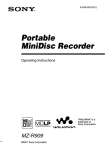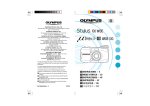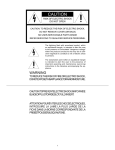Download 2nd Ave. Olympus Infinity Zoom 76 Owner's Manual
Transcript
INSTRUCTIONS Table of contents Description of controls .................................................. 3 Before you begin Loading the batteries ............................................. 6 Checking the batteries .......................................... 7 Attaching the strap ................................................. 8 Loading the film .................................................... 9 Unloading the film ................................................ 12 Simple point & shoot photography How to take pictures ........................................... 14 Auto flash photography (1)Taking pictures in low light ............................ 20 (2)Taking backlit subjects .................................... 23 Advanced shooting techniques Macro photography ............................................ 24 1 Focus lock ............................................................ 25 Selftimer ............................................................... 28 Continuous mode ................................................. 30 Auto-zoom mode .................................................. 31 Pre-focus mode .................................................... 33 AUTO-S flash photography ................................... 35 Flash OFF ............................................................. 37 FILL-IN flash ........................................................ 38 MULTI flash ......................................................... 39 Night scene flash photography ................................ 41 How to use the soft case (optional) ............................... 43 Care and storage ......................................................... 44 Questions and answers ............................................... 46 Specifications ............................................................. 47 Thank you for purchasing the OLYMPUS Infinity Zoom 76. Please read this instruction manual carefully before using the camera. This camera will not operate unless the batteries are loaded and the power switch is set to ON. Before taking important pictures, it is recommended that you shoot a roll of film just to familiarize yourself with the camera's features. Symbols used in this manual Correct Attention Incorrect Operation Operation sound Order Lamp on Operation order Lamp blinking Automatic operation Press lightly 2 Description of controls LCD panel Light sensor Viewfinder Shutter release button Autofocus windows Steady grip Power switch 3 Selftimer indicator Subject button Flash mode button Flash reflector Lens Strap eyelet Zoom buttons Back cover Viewfinder Battery compartment cover Film window Back cover release Tripod socket Rewind button 4 Viewfinder display LCD panel Selftimer Close-up correction marks Continuous mode Auto-zoom Pre-focus Autofocus frame AF indicator (green) Battery check indicator Exposure counter Flash mode selection indicator Flash indicator (orange) 5 Flash mode indicator Before you begin··· Insert a coin into the groove of the battery cover on the side of the grip and open the cover. Insert two 3V lithium batteries as shown and replace the cover. Use Panasonic CR123A, Duracell DL123A, or equivalent. * Do not mix different types of batteries or new and old batteries at the same time. * Remove batteries if you do not plan to use the camera for an extended period of time Loading the batteries (more than a year). 6 Set the power switch to ON to check the batteries. The battery check indicator will be displayed for 12 seconds. Checking the batteries 7 When is displayed, batteries are OK. If flashes, batteries are low, have spares handy. If is displayed continuously, batteries should be replaced immediately. * When the battery power is low, the flash will take longer to recharge. * Before replacing the batteries, set the power switch to OFF. Attaching the strap 8 Open the back cover by sliding the back cover release toward the top of the camera. Loading the film This camera is designed to use DX-coded 35mm film. DX coding, used by virtually all major film manufacturers, allows the camera to identify and set the film speed automatically. If DX-coded film is unavailable, use ISO 100 film. 9 Insert the film cartridge into the camera. Always avoid direct sunlight when loading the film. Make sure the film lies flat. Align the film leader with the red film loading indicator. Unless the film leader matches the film loading indicator, the film may not be loaded. * Do not touch the lens inside the body with your fingers or the film leader. 10 Close the back cover. The film automatically advances to the first frame. Set the power switch to ON to make sure that the exposure counter shows "1". If film is improperly loaded, the LCD panel will display a blinking "E". In this case, open the back cover, and realign the film leader. 11 Use the window in the camera back to check type of film loaded. The camera automatically rewinds the film when you reach the end of a roll. The exposure counter on the LCD panel counts down as the film is rewinding. Unloading the film If you want to rewind the film before the end of the roll, press the rewind button with the tip of a ballpoint pen. Do not use any device with a sharp tip. * The final reading of the exposure counter before rewinding may be more than the number of exposures specified for the film. 12 Once the film has been rewound, a blinking "E" will be displayed on the LCD panel. Further operations are not possible until the rewound film cartridge is removed. "Rewinding completed" indicator When the power switch is OFF, there will be no indication on the LCD panel. When the power switch 13 is ON Open the back cover, and remove the film cartridge from the camera. Avoid direct sunlight when removing the film. Simple point & shoot photography Set the power switch to ON. * When the camera is not in use, always set the power switch to OFF so that the shutter cannot be activated accidentally. While looking through the viewfinder, aim the camera at your subject. How to take pictures When the power switch is ON, the LCD panel lights. The LCD panel goes out after 4 to 5 minutes to minimize battery drain. The lens will then zoom to the wide-angle position. After 4 hours the power is automatically turned to OFF. To resume operation, set the power switch to OFF and then to ON again. 14 Use the zoom button to adjust the size of your subject in the frame. (telephoto or wide-angle) The shutter release cannot be operated while zooming. 15 Press the "T" (Telephoto) on the zoom button to zoom in. (The maximum focal length in the "T" position is 76mm.) Press the "W" (Wide-angle) on the zoom button to zoom out. (The minimum focal length in the "W" position is 38mm). Hold the camera correctly. It is particularly important to hold the camera steady when shooting at a longer focal length; use both hands for maximum stability. * Keep your fingers and the strap away from the lens and flash. 16 Position your subject within the autofocus frame in the center of the viewfinder. Press the shutter release button halfway to focus. When correct focus has been achieved, the autofocus indicator (green) will light up in the viewfinder. If the autofocus indicator is blinking, correct focus was not achieved. If this occurs, let go of the shutter release button. Make sure your subject is within the autofocus frame in the center of the viewfinder and press the shutter release button halfway again. Autofocus frame Picture frame 17 The entire subject should normally be positioned within the picture frame, however, the actual available image area will become smaller as you get nearer to the subject. At 0.6m(2ft), the subject should be positioned within the close-up correction marks. Shooting range: from 0.6m(2ft) to (infinity). Picture frame at (infinity) Close-up correction marks Picture frame at 0.6m (2ft) 18 If the subject is nearer than 0.6m(2ft), the autofocus indicator (green) will blink and the shutter will not release. However, the shutter may sometimes be released erroneously when the subject is extremely close to the camera. 19 When correct focus has been achieved (the autofocus indicator has lit up), press the shutter release button fully (gently, to minimize camera shake). As soon as the shutter is released, film will automatically advance to the next frame. The LCD exposure counter shows the next frame number. Auto flash photography (1)Taking pictures in low light Confirm flash charge by pressing the shutter release button halfway. The flash indicator (orange) will light up in the viewfinder when the flash is charged. Compose your shot and press the shutter release button. The flash will fire automatically. The shutter release cannot be operated while the flash is still charging. It takes about 0.2-3.5 seconds after the film is advanced to recharge the flash (at normal temperatures with new batteries). Use the AUTO-S flash mode to prevent the red-eye phenomenon (P.35). When the flash mode is set to AUTO or AUTO-S, the flash will fire automatically in low light conditions. 20 From 0.6m(2ft) .to 1.6m(5.2ft), the flash strength is controlled automatically as shown. This soft flash mechanism prevents pictures from being overexposed. Overexposed (with conventional flash). Properly exposed (with soft flash). Soft flash: Maximum ISO100 Flash strength Distance 21 Color negative film offers the widest exposure latitude, compensating for over and underexposure more readily Flash working range: ISO 100 200 WIDE(38mm) 0.6m - 4.1m(2ft - 13.4ft) 0.6m - 5.8m(2ft - 19ft) 400 0.6m - 8.2m(2ft - 26.9ft) In continuous mode ISO WIDE(38mm) 100 0.6m - 2.9m(2ft - 9.5ft) 200 0.6m - 4.1m(2ft - 13.4ft) 400 0.6m - 5.8m(2ft - 19ft) than other films. The flash working range shown below is optional for color negative film. Actual flash working range for other film type may vary. TELE(76mm) 0.6m - 3m(2ft - 9.8ft) 0.6m - 4.2m(2ft - 13.8ft) 0.6m - 6m(2ft - 19.7ft) TELE(76mm) 0.6m - 2m(2ft - 6.6ft) 0.6m - 3m(2ft - 9.8ft) 0.6m - 4m(2ft - 13.1ft) 22 Confirm flash charge by pressing the shutter release button halfway. The flash indicator (orange) will light up in the viewfinder when the flash is charged. * If the backlit subject is very small Auto flash photography (2)Taking backlit subjects When the flash mode is set to AUTO or AUTO-S, the flash will fire automatically in backlit situations. 23 and does not fully cover the autofocus frame, the flash may not fire automatically. Advanced shooting techniques Macro photography At 0.6m(2ft), position your subject within the area outlined by the closeup correction marks. * When the subject is close to the camera, use a tripod or other camera support to prevent the effects of camera shake. Focal length of 38mm at 0.6m(2ft). Macro photography is possible at any focal length. Without performing any special operations, it is possible to take close-up pictures up to a distance of 0.6m(2ft). 24 Focus lock Focal length of 76mm at 0.6m(2ft). Using the focus lock, your subject will be in focus even if it is not in the center of the picture. 25 When the main subject is not in the autofocus frame, use the focus lock. Otherwise the camera will focus on the background and the subject will not be in focus. Position your subject in the autofocus frame and press the shutter release button halfway. When correct focus has been achieved, the autofocus indicator (green) will light up in the viewfinder. The focus and the exposure will be locked. 26 While keeping the shutter release button pressed halfway, change the position of your subject in the viewfinder to achieve the desired composition. 27 Press the shutter release button fully to take the picture. Set the camera firmly in position. Press the SUBJECT button until is displayed on the LCD panel. Press the shutter release button halfway to focus. When correct focus has been achieved, the autofocus indicator (green) will light up in the viewfinder. Selftimer 28 Press the shutter release button fully to start the selftimer. The shutter will be released 12 seconds later. The selftimer indicator on the front of the camera will light up for the first 10 seconds, then blink rapidly for 2 seconds until the shutter is released. * During selftimer operation, the focus and exposure will be locked when the shutter release button is pressed. * To cancel the selftimer after it has been activated, press the SUBJECT button or set the power switch to OFF. Selftimer indicator lights for the first 10 sec. Selftimer indicator then blinks for 2 sec. 29 Press the SUBJECT button until "C" is displayed on the LCD panel. The camera will shoot repeatedly as long as the shutter release button is pressed. Outside the shooting range (P. 18) the shutter will automatically stop. Continuous mode Use continuous mode to shoot a continuous series of pictures at approx. 1 frame per 1.7 seconds. (1 frame per approx. 4 seconds when the flash is fired.) 30 Press the SUBJECT button until is displayed on the LCD panel. Auto-zoom mode Use auto-zoom mode to maintain a constant head and shoulders subject size within the frame, even though the distance to the subject may vary. 31 Press the shutter release button. The lens will automatically zoom and after the appropriate subject size has been achieved the shutter will be released. Auto-zoom mode working range: from 1.3m (4.3ft) to 2.6m (8.5ft). * Outside the ranges as shown, autozoom may not operate. * Even in the auto-zoom mode, the zoom button can be operated to override the automatic zoom setting. 32 Press the SUBJECT button until "PRE FOCUS" is displayed on the LCD panel. Pre-focus mode Use pre-focus mode when you want the shutter to release the moment you press the shutter release button. It is useful when taking moving subjects such as at a sports event. 33 Press the shutter release button halfway to focus on your subject. The autofocus indicator (green) will light up and you will hear a "click". Press the shutter release button fully. The shutter will be immediately released. By using this mode, the time lapse between when the shutter button is released and when the picture is actually taken is reduced. 34 Press the FLASH button to set the mode to AUTO-S. will light on the LCD panel. AUTO-S flash photography 35 Auto-S flash significantly reduces "red-eye" phenomenon (when a subject's eyes appear red) in flash portraits and group photos. Red-eye phenomenon is most likely to occur in very low light, and at longer focal lengths (telephoto). Compose your shot and press the shutter release button. The flash will emit a rapid series of low power preflashes, followed directly by the main flash. * Hold the camera firmly while pressing the shutter release button. * Auto-S mode will not be cancelled when power is switched OFF. To cancel AUTO-S mode, press the FLASH button. AUTO-S flash mode working range: ISO WIDE(38mm) TELE(76mm) 100 0.6 - 4.1m (2 - 13.4ft) 0.6 - 3m (2 - 9.8ft) 200 0.6 - 5.8m (2 - 19ft) 0.6 - 4.2m (2 - 13.8ft) 400 0.6 - 8.2m (2 - 26.9ft) 0.6 - 6m (2 - 19.7ft) 36 Press the FLASH button to set the flash mode to OFF. will light on the LCD panel. Flash OFF Use this mode for photography utilizing available light, in situations where flash photography is prohibited or when you don't want the flash to fire, such as for a night scene. 37 * In low lit conditions, the necessary shutter speed may be very slow (up to 2 seconds) to attain proper exposure. To prevent blurred pictures resulting from camera shake, the camera should be set firmly in position (with a tripod for example). FILL-IN flash In this mode, the flash always fires regardless of available light. Use this mode for daylight shooting in backlit conditions to compensate for backlighting which may make the subject appear too dark. By using the FILL-IN mode, the subject will be properly lit by the flash. 38 Press the FLASH button to set the flash mode to MULTI. will light on the LCD panel. The flash will fire four times. The shutter speed is set to 1/6 sec. Press the FLASH button to set the flash mode to FILL-IN. will light on the LCD panel. MULTI flash Use this mode, when you want to segment a motion sequence — such as a golf swing — in 1 frame. For best results use together with pre-focus mode. 39 * Use this mode in low light. If you use it in bright conditions, your picture will be overexposed. * Use a tripod or other camera support to prevent the effects of camera shake. MULTI flash mode working range: ISO WIDE(38mm) 100 0.6 - 3.1m (2 - 10.2ft) 0.6 - 2.2m (2 - 7.2ft) 200 0.6 - 4.4m (2 - 14.4ft) 0.6 - 3.1m (2 - 10.2ft) 400 0.6 - 6.2m (2 - 20.3ft) 0.6 - 4.4m (2 - 14.4ft) TELE(76mm) 40 Press the FLASH button to set the flash mode to will light on the LCD panel. Night scene flash photography Use slow-synchoro FILLIN flash to capture dimly lit backgrounds, such as the sky at dusk, while properly lighting the foreground with flash. 41 With the flash AUTO mode, only the subject can be taken. By using the flash mode for night scene photography, you can take both * The necessary shutter speed may be the subject in the foreground and the night scene in the background. attain proper exposure. To prevent blurred pictures resulting from camera shake, the camera should be set firmly in position (with a tripod for example). very slow (up to 2 seconds) to 42 Make sure to set the power switch to OFF before the camera is inserted into the case. How to use the soft case (optional) 43 Care and storage Never disassemble the camera; it contains a high-voltage circuit. Do not use thinner, benzine or organic solvents to clean the camera. Do not touch the DX read-off contacts. Do not disassemble or expose batteries to excessive heat. Do not rotate the camera once it is mounted on a tripod. Use the tripod swivel to vary direction. Do not open the back cover while it is mounted on a tripod. 44 Do not expose the camera to extreme heat (over 40°C/104°F), such as inside a car during the hot summer weather, or to extreme cold (below -10°C/14°F). 45 Do not leave the camera near magnetic fields, like on top of a TV set, or radio. In case of malfunction, take the camera to your nearest Olympus dealer or service center. Questions and answers Q: What kind of batteries should I use? A: Use two 3V lithium batteries (DL123A or CR123A). Do not mix new and old batteries at the same time. Change them both at the same time. Q: How long will the battery last? A: If you use 24-exposure rolls of film and expose half of all your pictures with flash, two new 3V lithium batteries (DL 123A/CR123A) will allow you to take 30 or more rolls of film. If you do not use flash and zoom so often, the batteries will last much longer. Q: The camera does not operate. What should I do? A: (1)Make sure the power switch is ON. (2)Make sure there are batteries in the camera, and that they are inserted correctly. (Refer to page 6.) (3)If the film has been rewound, the camera will not operate until the back cover is opened. (4)While the flash is being charged, the shutter will not release. (5)If the distance range to the subject is less than 0.6m, the shutter will not release. Q: The camera does not focus correctly. What should I do? A: (1) In the following situations, the camera's autofocus mechanism may not function properly. Compose your picture by focusing on a different subject which is in the same range as your subject. Objects that reflect too much light Black objects Pictures taken through a glass window or wire screening Pictures including flames or smoke When the sun is included in the picture (2) Use the focus lock when the subject is not in the center of the picture. (Refer to P.25) Q: The flash does not fire. A: Make sure the flash mode is not set to OFF mode. Q: The camera fails to operate in cold weather. What can I do? A: Generally, low temperatures will reduce the battery performance temporarily. Try to keep the camera warm 46 before using them. Specifications Type: Full-automatic 35mm autofocus lens-shutter camera with built-in 38 - 76 zoom lens. Film format: 35mm standard DX coded film (24 x 36mm) Lens: Olympus lens 38 - 76mm F4.5 - 6.2, 7 elements in 7 groups. Shutter: Programmed electronic shutter. Focusing: Active type infrared autofocus system, focus lock possible. Focusing range: 0.6m (2ft) (infinity) Viewfinder: Kepler type zoom-finder (with autofocus frame, close-up correction marks, autofocus indicator and flash indicator). Exposure control: Programmed automatic exposure control. Center-weighted average light metering. Auto exposure range: Wide-angle: EV 3.4 (F4.5, 2 sec.) to EV16 (Fl 1 1/500 sec.) Telephoto: EV4.3 (F6.2, 2 sec.) to EV17 (F16, 1/500 sec.). 47 Exposure counter: Progressive type with automatic reset, displayed on LCD panel. Selftimer: Electronic selftimer with 12 sec. delay. Film speed range: Automatic setting with DX coded film ISO 50 - 3200. (color negative film). Actual setting points at ISO 50, 100, 200, 400, 800, 1600, 3200. For non-DX coded film, film speed is set to ISO 100. Film loading: Automatic loading (automatically advances to first frame when camera back is closed). Film advance: Automatic film winding. Film rewind: Automatic film rewind (automatic rewind activation at end of film, automatic rewind stop). Rewind possible at any point with rewind button. Flash: Built-in flash. Recycling time: approx 0.2 - 3.5 sec. (at normal temperature with new batteries). Flash working range (ISO 100 color negative film): Wide-angle: 0.6m - 4.1m (2ft - 13.4ft), Telephoto: 0.6m - 3m (2ft - 9.8ft) Flash working range (ISO 400 color negative film): Wide-angle: 0.6 - 8.2m (2ft - 26.9ft), Telephoto: 0.6m - 6m (2ft - 19.7ft) Flash modes: AUTO (Automatic flash activation in low light and backlight) Auto-S (Red-eye reducing, in low light and backlight) OFF (No flash) FILL-IN (Forced activation) MULTI (4 activations at fixed shutter speeds of 1/6 sec.) (For night scene at a maximum shutter speed of 2 seconds.) Battery check: Displayed on LCD panel Power source: Two 3V lithium batteries (DL123A/CR123A) Dimensions: 138(W) x 74(H) x 64(D)mm (5-7/16 x 2-15/16 x 2-1/2 in.) Weight: 360g (12.7oz) (without battery). *Specifications and design are subject to change without notice. 48 OLYMPUS OPTICAL CO., LTD. San-Ei Building, 22-2. Nishi Shinjuku 1-chome, Shinjuku-ku, Tokyo, Japan Tel: 03-3340-2211 OLYMPUS CORPORATION Crossways Park, Woodbury, New York 11797-2087, U.S.A. Tel: 516-364-3000 OLYMPUS OPTICAL CO. (EUROPA) GMBH Postfach 104908, Wendenstrasse 14-16, 2000 Hamburg 1, Germany Tel: 040-23773-0 OLYMPUS OPTICAL CO. (U.K.) LTD. 2-8 Honduras Street, London EC1Y OTX, England Tel: 01-253-2772































































